Sari Burma, or Burma Baklava, is a rolled baklava featuring the same beloved flavors and ingredients as its layered cousin. They are relatively easier to assemble than traditional baklava, and are packed with even more cinnamon walnut filling!
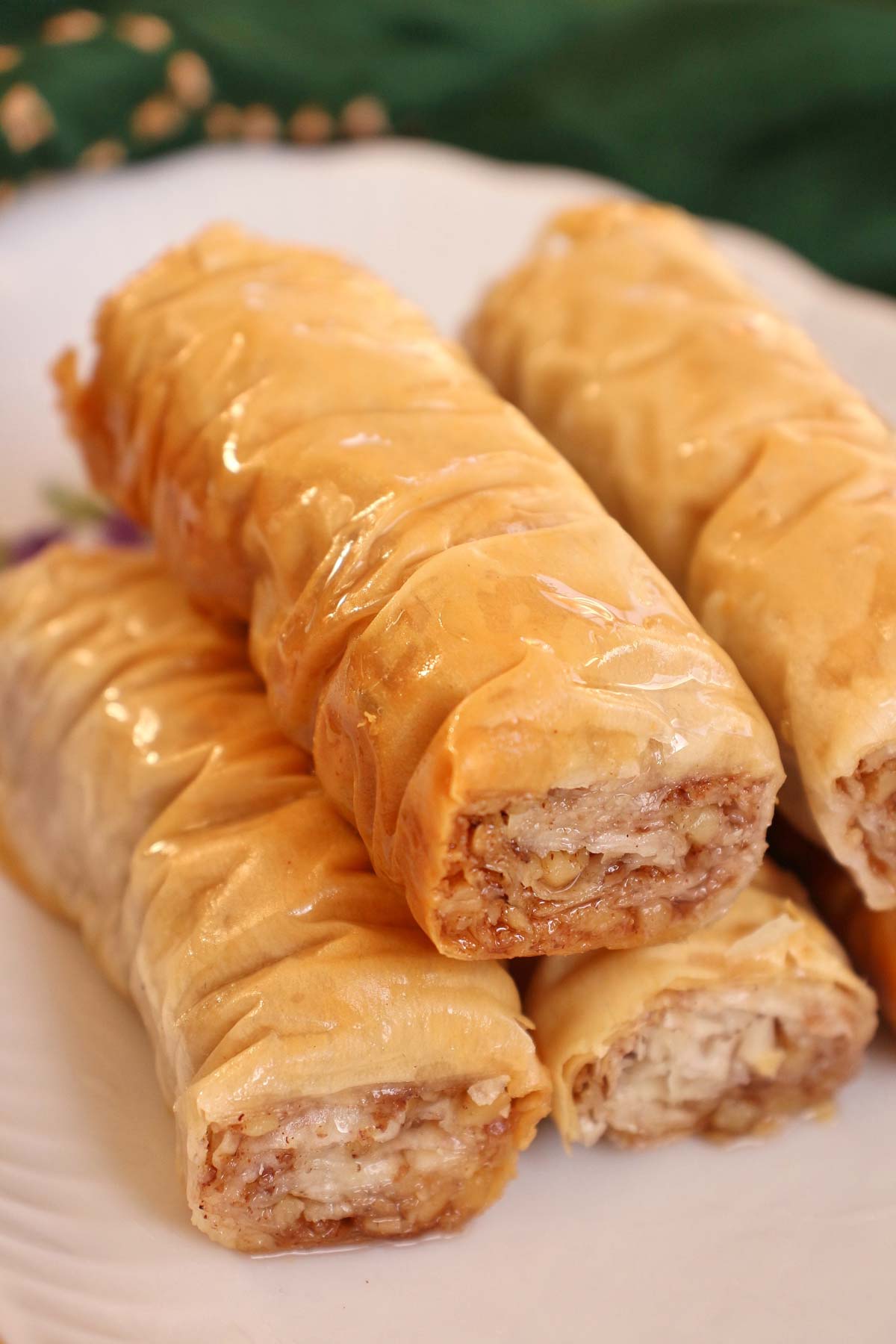
Sari Burma translates to "yellow twist" in Turkish, so the name describes the pastry quite well. It's similar to baklava or paklava and uses almost the same exact ingredient list, but with a more robust and plentiful walnut filling.
I find this rolled baklava to be easier to assemble than the traditional layered version. Because you are intentionally manipulating the dough to create a crinkled look, it's a much more forgiving recipe for those who are nervous about working with phyllo dough, which can easily tear due to its delicate nature.
If you love the flavor of Armenian paklava but are a novice to the art of handling phyllo dough, this is a great introductory recipe. And if I'm being completely honest, I actually prefer this rolled baklava to traditional paklava. There's something about its fun shape and plethora of walnut filling that really steals my heart!
Ingredient notes
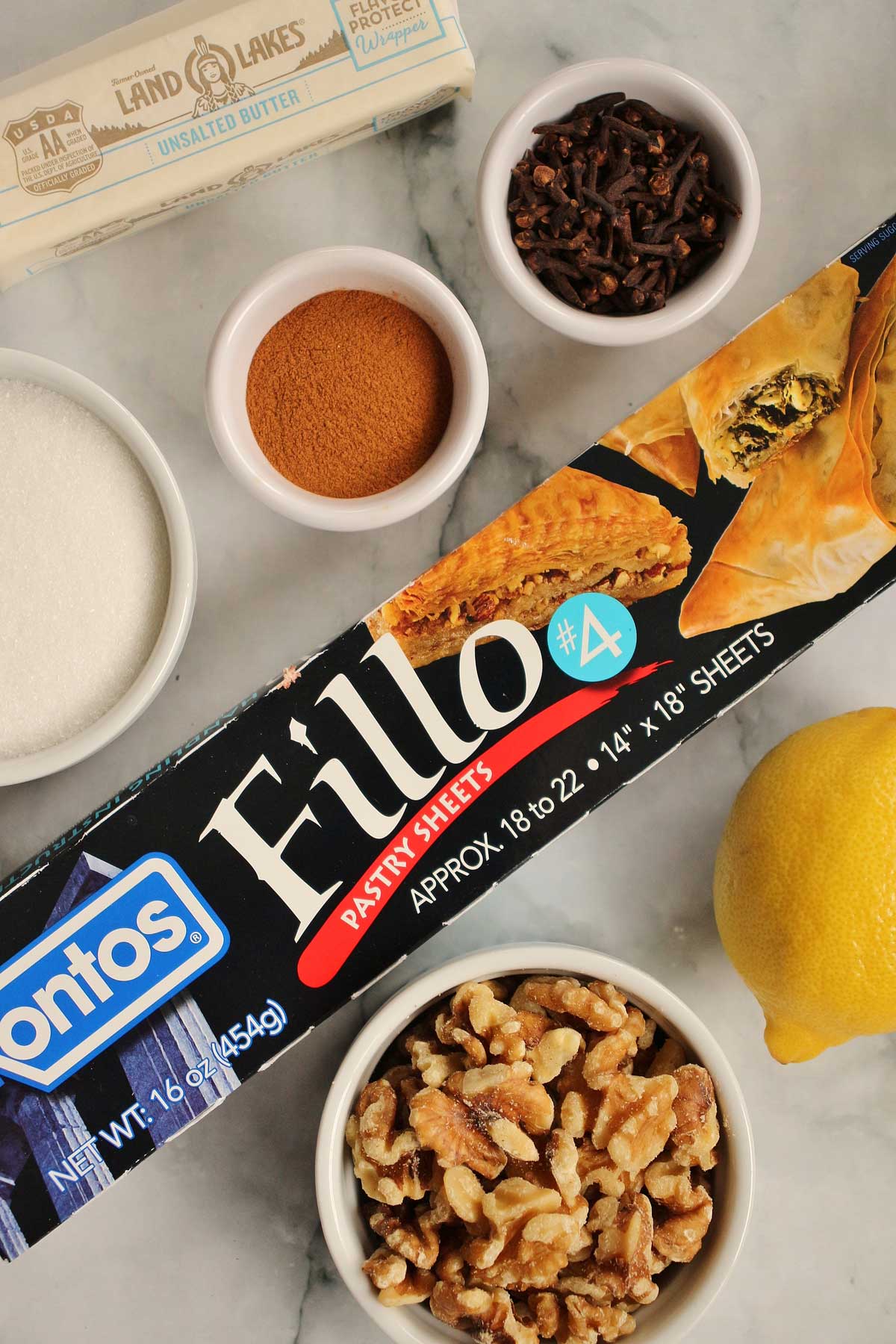
- Phyllo/Fillo Dough:
- These paper thin sheets of pastry dough can be spelled either phyllo or fillo. They are typically sold in 1 pound packages and are available in many grocery store frozen food sections.
- The most popular brands you’ll find on the market include Kontos, Athens, Apollo, and The Fillo Factory.
- Additionally, there are different thicknesses of phyllo dough sheets. The #4 is the thinnest one on the market and the one we use and recommend. It yields ideal results for various recipes. Next is #7 which is a bit thicker and good for beginners. You’ll have less sheets per 1 pound box if you use #7. There is also a #10 country style phyllo which is even thicker with even less sheets per pound box.
- Some brands offer different dimensions of phyllo dough depending on the thickness, but the most common dimensions for phyllo dough sheets is 14-by-18-inches. This is what we use for the burma baklava.
- Phyllo dough is typically sold frozen. Place your box of phyllo in the refrigerator overnight to gently thaw it before using.
- Clarified Butter: It is important to use clarified butter rather than regular melted butter. Butter contains fat, water, and milk proteins, but you want to isolate the butterfat only to brush on your phyllo. If you don’t do this, your layers will not be as flaky and golden. Also you will end up with dark, burned-looking specks which are the bits of milk protein browning on your rolled baklava surface. You can clarify butter yourself (I include instructions in my tips below) or purchase ghee (clarified butter). If you use store-bought ghee, reduce the amount of butter in the recipe to about 4 ½ ounces (by weight) to make up for the evaporation of water and skimming of milk solids.
- Walnuts: You can use other nuts to fill your sari burma, but we always use walnuts only. You can chop them by hand into roughly ¼-inch pieces, pulse them in a food processor, or use a nut chopper which is what we have used for years for this recipe.
- Sugar: Plain white granulated sugar is best for sweetening your walnut filling and making the sugar syrup.
- Lemon Juice: This serves a very important purpose in making the syrup. Believe it or not it’s not simply for flavor. When boiling the sugar and water together for your syrup it will be quite cloudy. The moment you add the lemon juice you’ll see the mixture becomes clear. The lemon juice helps clarify your syrup and prevent it from crystalizing. Do not skip it!
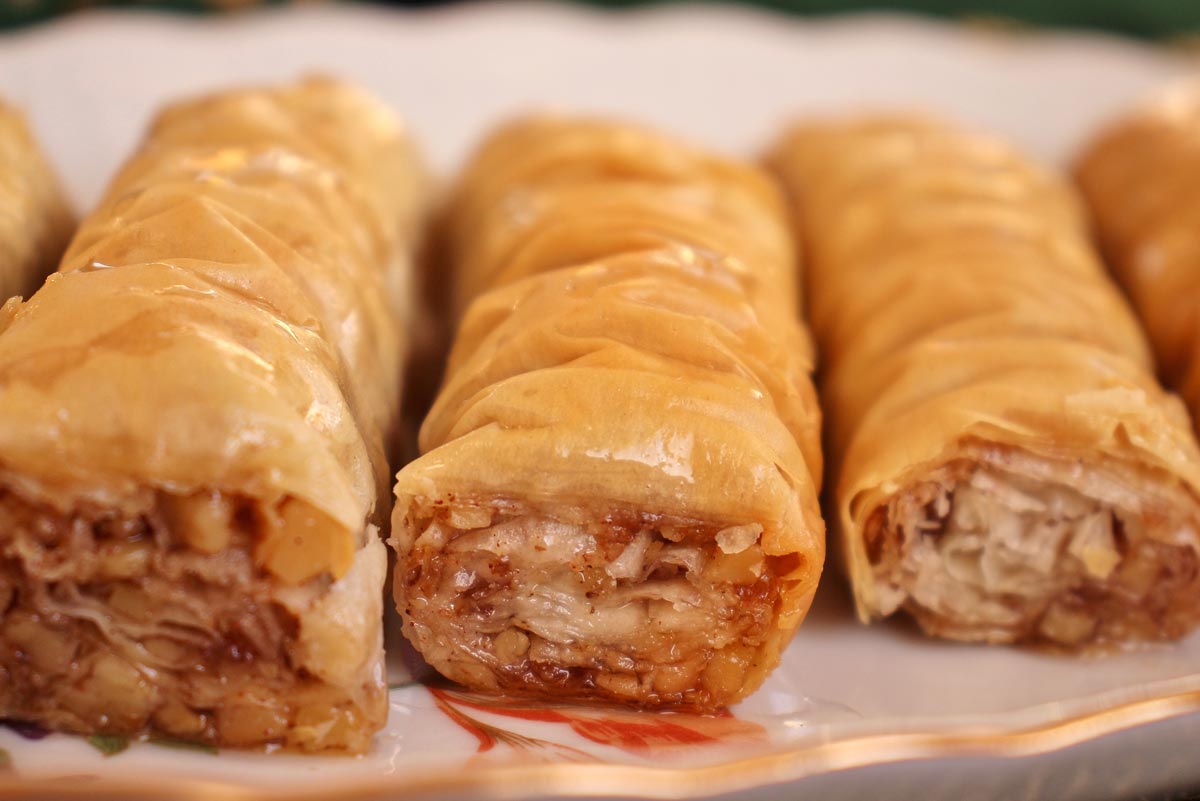
How to make it
Prepare the filling by mixing together chopped walnuts, sugar and ground cinnamon.
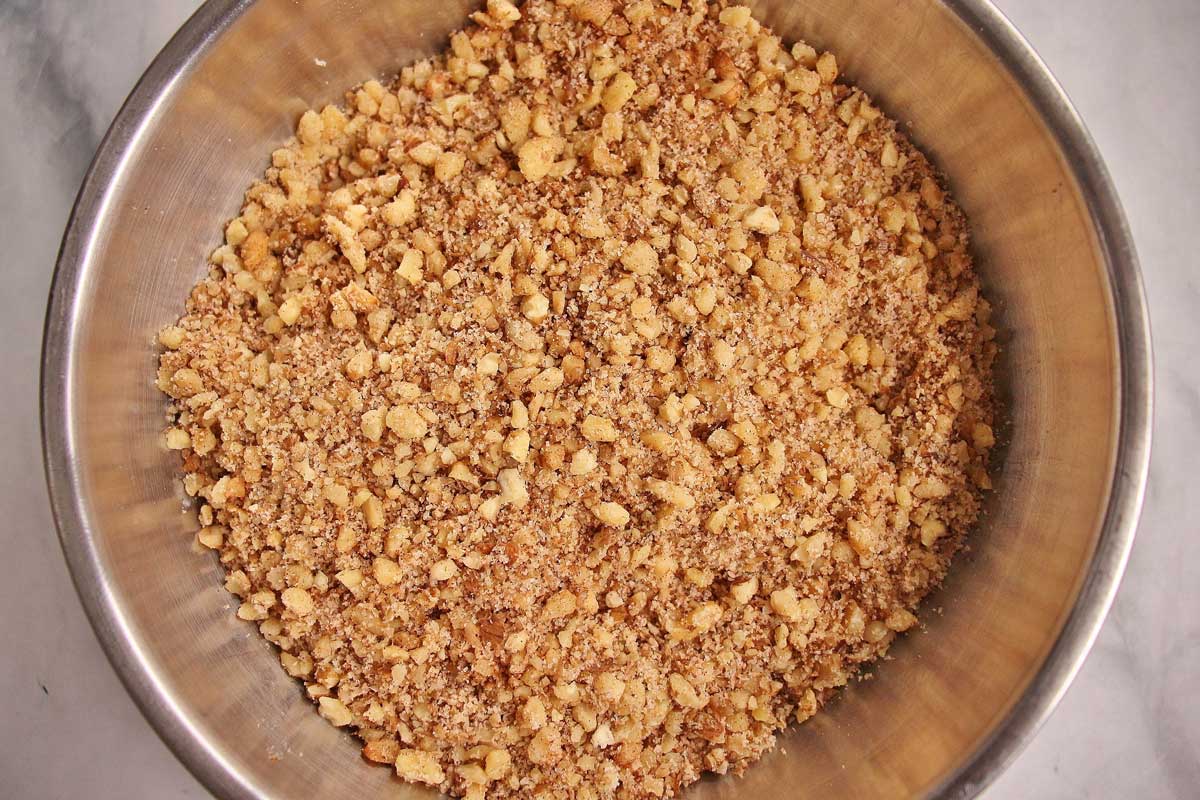
Open the package of phyllo dough and lay it out on the table or a clean work surface. Cover with a clean cloth when not using it so it doesn't dry out.
Take one sheet of dough at a time and fold it in half width-wise (like a book). Brush/blot lightly with butter (PHOTO 1). Sprinkle about 3 tablespoons of filling over most of the dough, leaving about 3 inches free at the top edge, and about ½ an inch free at the other 3 edges (PHOTO 2).
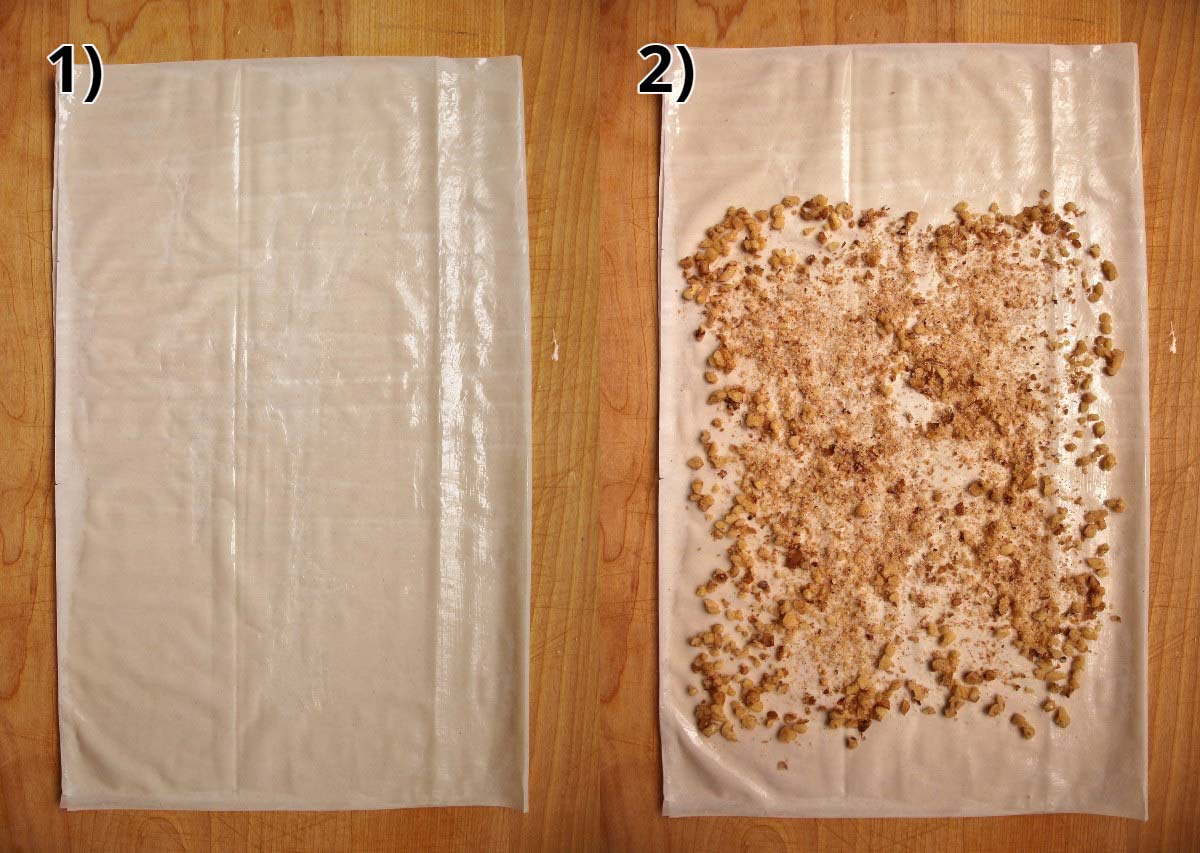
Fold 1 inch over at the bottom and place the dowel here (PHOTOS 3-4).
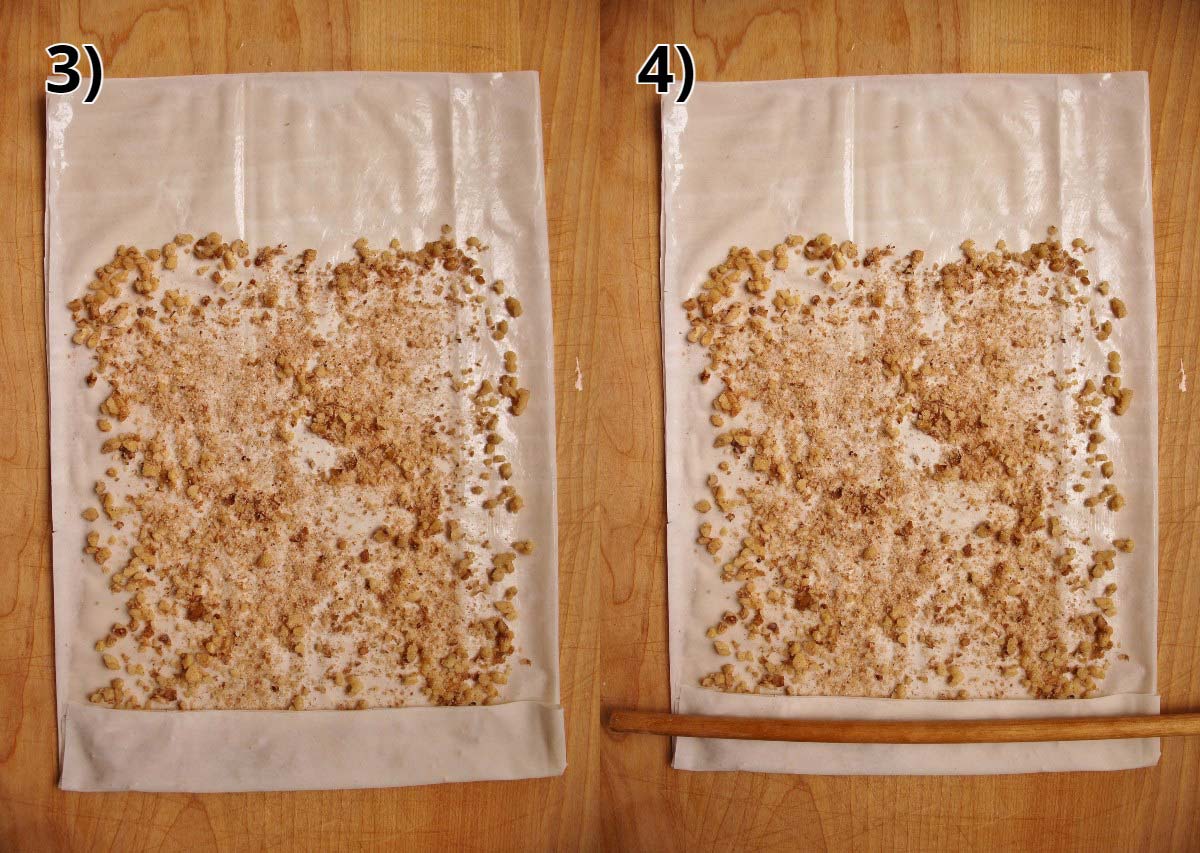
Roll up from this end, finishing at the filling-free end (PHOTOS 5-6). Set the seam side down. Push the 2 ends together toward the center using both hands, giving the dough a crinkled look (PHOTO 7). Remove the dowel (PHOTO 8) and place the sari burma in a greased 9 ½-by-14 ½-inch pan.
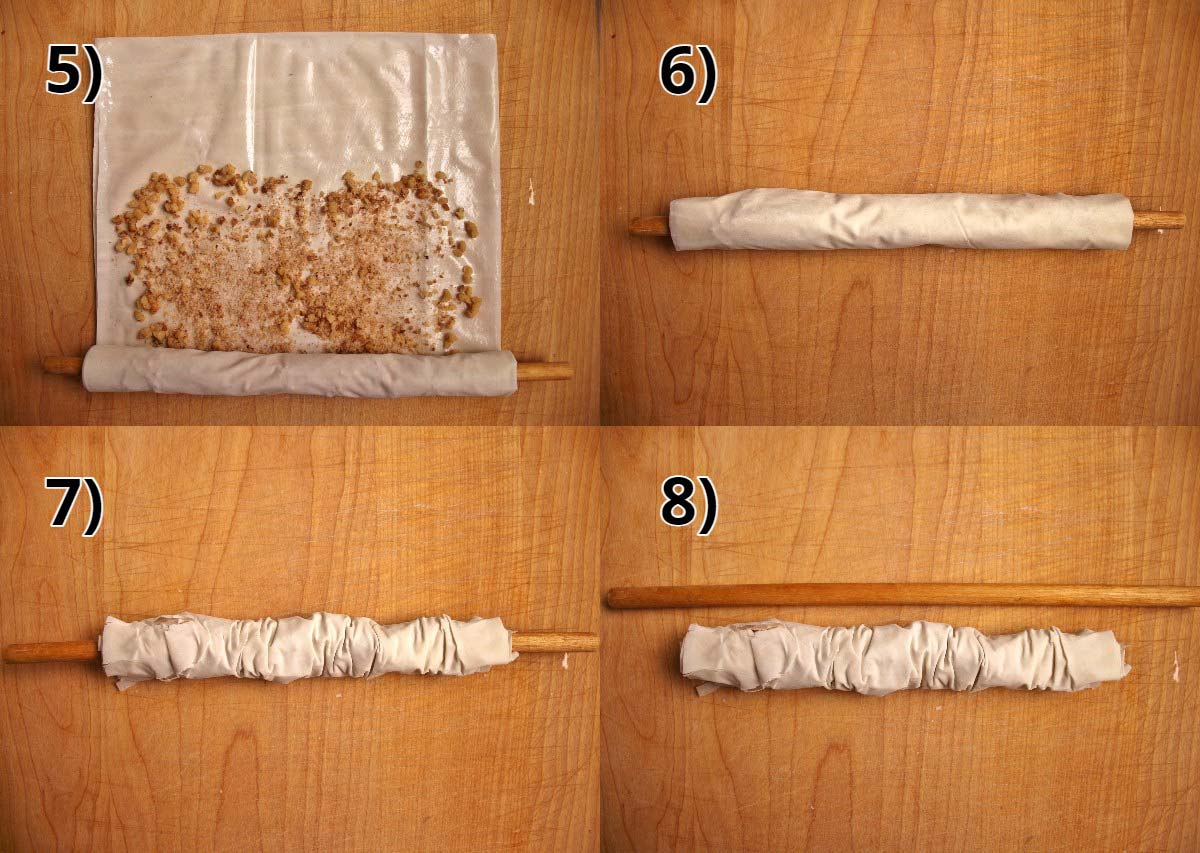
Repeat with the rest of the dough and then brush the tops of all of them liberally with melted clarified butter. Trim ½ inch from each end of every rolled baklava, and then cut the center part in half creating 2 pieces per roll (each about 3-inches long) with the trimmings on either side.
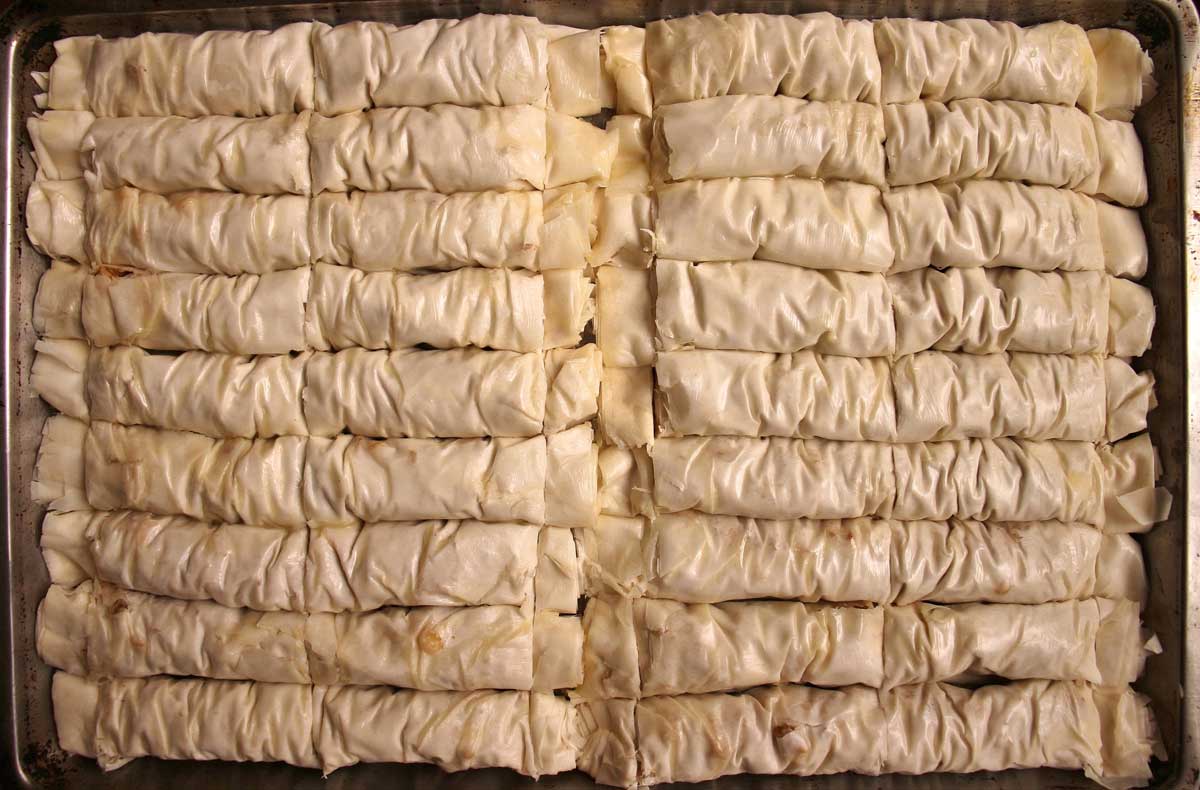
Bake at 350°F for about 35 to 45 minutes until golden brown. Cool completely.
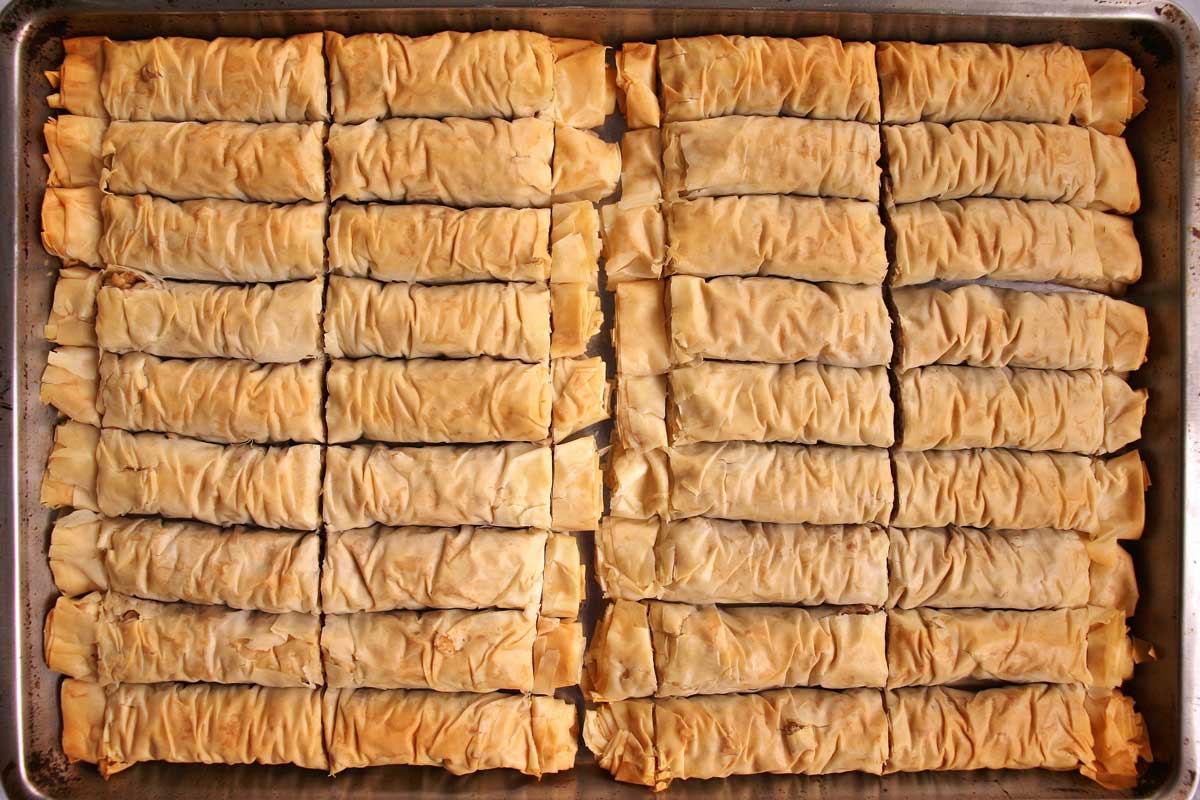
Prepare the syrup by dissolving the sugar in the water over high heat (PHOTO 9). Bring to a boil then add the lemon juice and cloves (PHOTO 10).
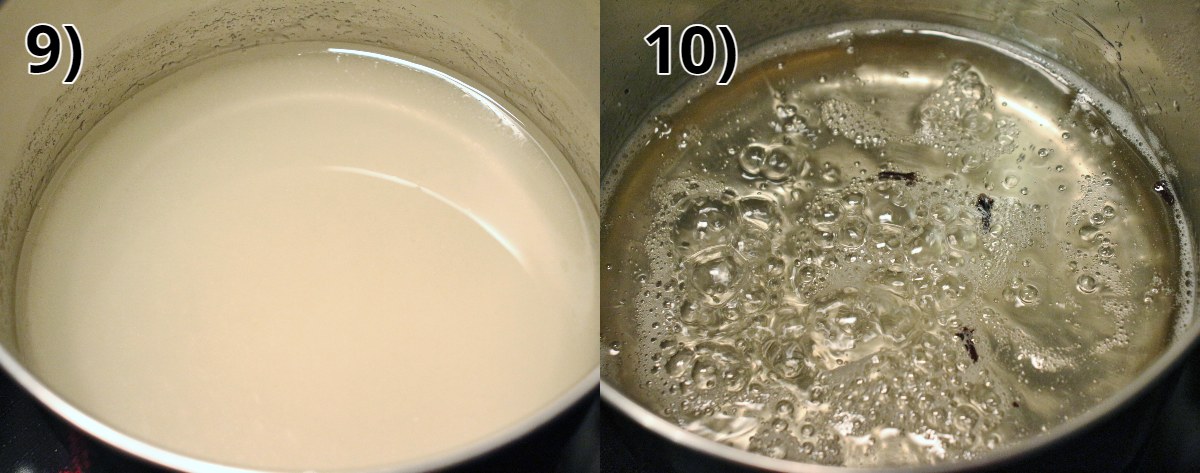
Lower the heat and simmer for about 10 minutes. Remove from the heat and rest for about 17 or 18 minutes until the syrup is warm, but not too hot (about 160 to 165°F).
Discard the cloves and ladle the very warm syrup over the pan of burma and let it soak until mostly absorbed, about 1 hour. There may still be some syrup left in the pan, but most of it should soak into the dough.
Use a sharp knife and go over all the previous cuts, making sure the rolled baklava is cut all the way through before serving.
Please scroll to the bottom of the post for the full recipe (in a printable recipe card) including ingredient amounts and detailed instructions.
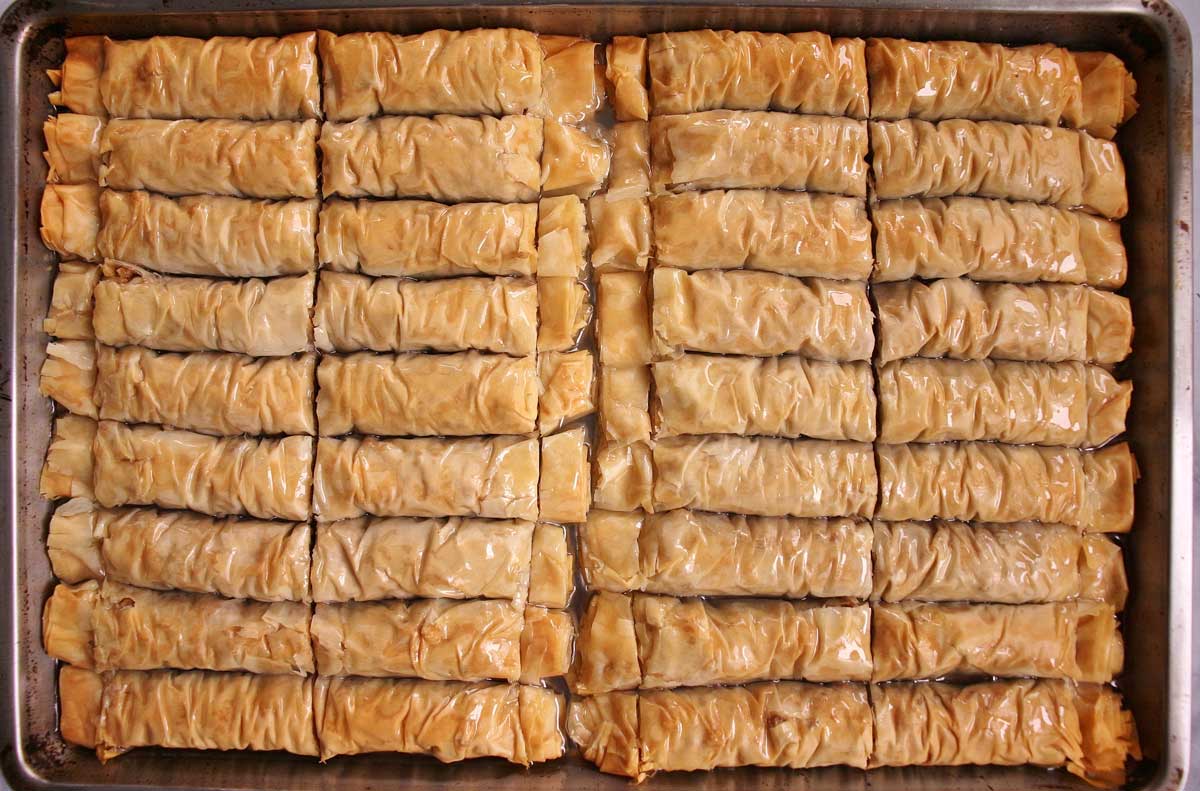
Expert tips and FAQ
Sari burma has a long shelf life. Store it in an airtight container at room temperature for up to 2 weeks. I do not recommend refrigerating it as it will change the texture considerably. We will often place individual pieces onto cupcake liners for a pretty presentation but also ease of transfer to serving platters, etc.
Be gentle when working with phyllo dough, as it can tear easily. It can also quickly dry out so it is imperative to keep your phyllo covered with a cloth when not working with it.
If you only have a 9-by-13-inch pan you can use this but trim/slice your rolled baklava before putting them in the pan so they can all fit, then discard the trimmings in this case.
It is very important that the burma baklava and syrup are 2 different temperatures. Some people pour cold syrup over hot sari burma but we always do the opposite with cooled sari burma and hot syrup. If both are hot, the result will be mushy. If they are both cold, the syrup won't soak into the burma at all.
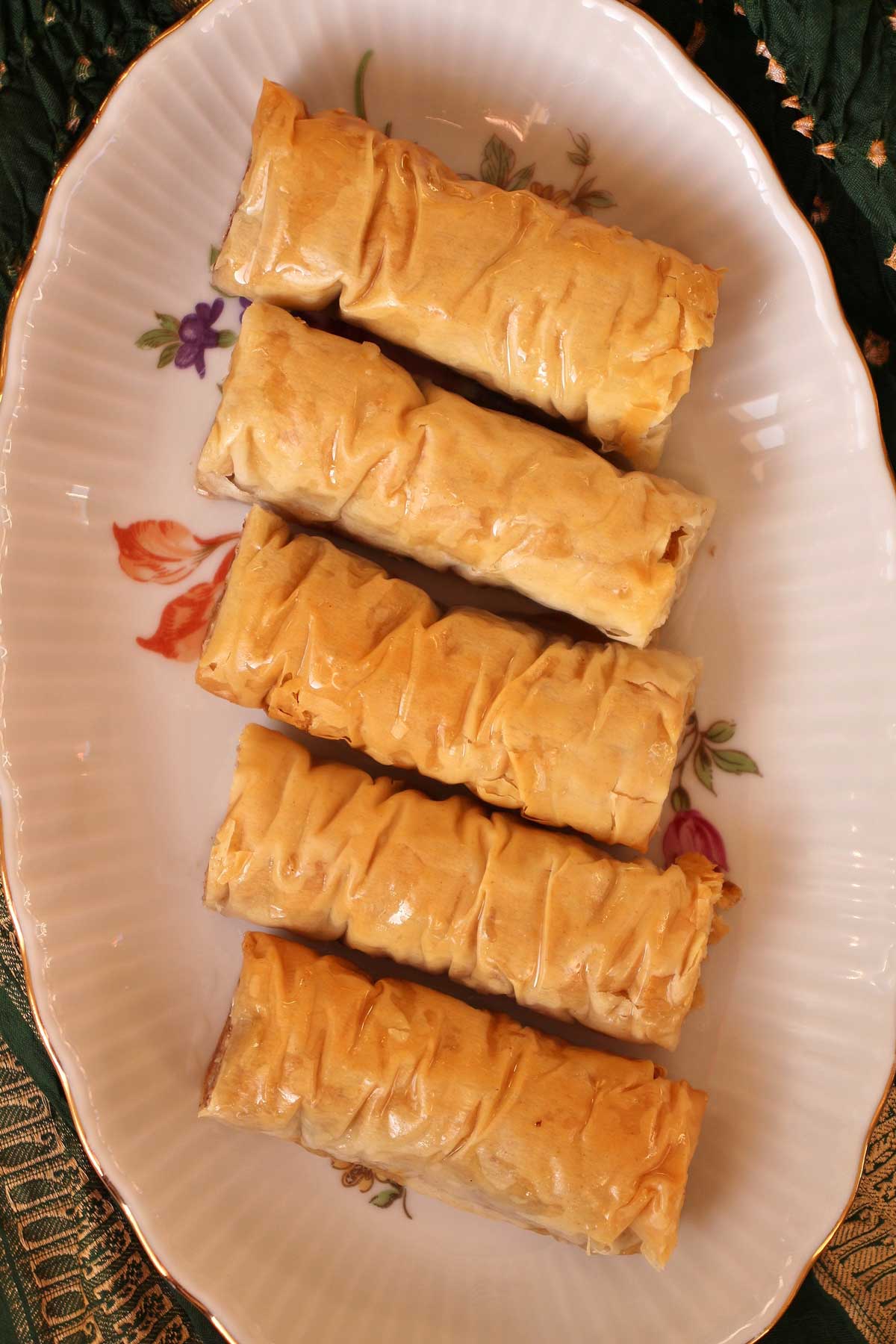
No, they are not the same and they are not usually interchangeable. Phyllo dough (also spelled fillo or filo) comes from the Greek word meaning "leaf." They are paper-thin sheets of dough made mostly of flour and water, and are typically layered or wrapped around fillings to create layers of crispy, flaky dough when baked. Puff pastry is made by laminating dough and butter together. This entails wrapping a giant square of cold butter with dough and then folding, rolling, and chilling repetitively to create alternating butter and dough layers. When baked it puffs up to produce separate flaky layers and a crunchy exterior.
Add unsalted butter to a saucepan. Melt it over medium-low heat without stirring it (you want the components of water, fat, and milk solids to separate without disturbance). The butter will begin to boil and milk proteins will form a white layer on the surface (PHOTO 1). It’s actually the water in the butter that is boiling, not the butterfat. You want to continue to cook the butter until all of the water has gently boiled off. You’ll notice the boiling itself will calm down as the water content diminishes.
Remove from the heat and use a spoon to skim off all the white milk solids floating on the surface, and discard (it’s easier to skim it without disturbing the layers once it’s no longer actively bubbling) (PHOTO 2). Now you can use the clarified butter, which is the pure butterfat. If you notice any white milky liquid on the bottom, that is residual water that hasn’t boiled off. Just use the yellow fat and stop once you hit the white watery residue at the bottom.
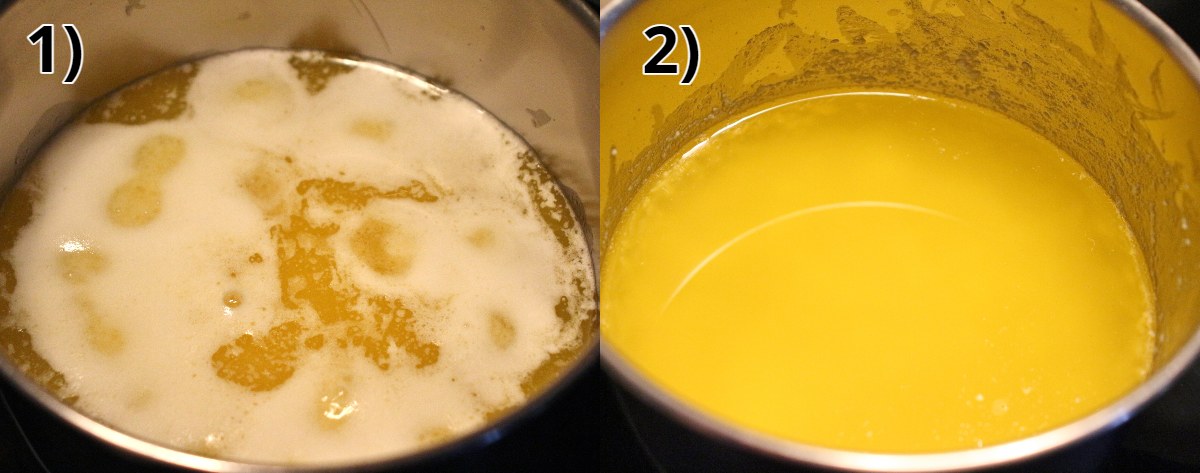
Other recipes you may like
- Paklava (Armenian Baklava)
- Kadaif or Kadayif (Ricotta Cheese Kunafa)
- Qatayef Asafiri / Atayef bil Ashta (Middle Eastern Cream Filled Pancakes)
- Armenian Gata
- Chorek (Armenian Sweet Bread)
- Matzoon Cookies (Armenian Yogurt Cookies)
- Browse all Armenian and Middle Eastern Recipes
Tried this recipe? Please leave a star ⭐️⭐️⭐️⭐️⭐️ rating in the recipe card below and/or a review in the comments section further down the page. You can also follow me on social media on Facebook, Instagram, and Pinterest!
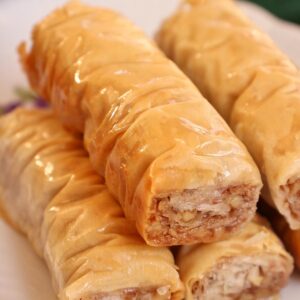
Sari Burma (Burma Baklava/Rolled Baklava)
Equipment
- ¼-to-½-inch diameter dowel (about 11-to-12 inches long is good)
Ingredients
- 1 pound (454 grams) phyllo (fillo) dough (approximately 14-by-18-inch; preferably #4 thickness) defrosted in the refrigerator overnight
- 6 ounces (1 ½ sticks / 170 grams) unsalted butter, melted and clarified
Filling:
- 12 ounces (340 grams) walnuts, finely chopped (3 cups chopped)
- 5 tablespoons granulated sugar
- 2 ¼ teaspoons ground cinnamon
Syrup:
- 2 cups (400 grams) granulated sugar
- ¾ cup water
- 1 tablespoon lemon juice
- 5 whole cloves
Instructions
- Preheat oven to 350°F. Grease a 9 ½-by-14 ½-inch pan.
- Prepare the filling by mixing together the walnuts, sugar and cinnamon. Set aside.
- Open the package of phyllo dough and lay it out on the table or a clean work surface. Cover with a clean cloth when not using it so it doesn't dry out. Take one sheet of dough at a time and fold it in half width-wise (like a book).
- Brush/blot lightly with butter. Sprinkle about 3 tablespoons of filling over most of the dough, leaving about 3 inches free at the top edge, and about ½ an inch free at the other 3 edges. Fold 1 inch over at the bottom and place the dowel here. Roll up from this end, finishing at the filling-free end.
- Set the seam side down. Push the 2 ends together toward the center using both hands, giving the dough a crinkled look. Remove the dowel and place the sari burma on the greased pan. Repeat with the rest of the dough and then brush the tops of all of them liberally with melted clarified butter. Trim ½ inch from each end of every sari burma, and then cut the center part in half creating 2 pieces per roll (each about 3-inches long) with the trimmings on either side (alternatively, for smaller sari burma, cut each center part into 3 pieces instead of 2).
- Bake for about 35 to 45 minutes until golden brown. Cool completely before moving on.
- Prepare the syrup by dissolving the sugar in the water over high heat. Bring to a boil then add the lemon juice and cloves, lower the heat and simmer for about 10 minutes. Remove from the heat and rest for about 17 or 18 minutes until the syrup is warm, but not too hot (about 160 to 165°F).
- Discard the cloves and ladle the very warm syrup over the pan of sari burma and let it soak until mostly absorbed, about 1 hour. There may still be some syrup left in the pan, but most of it should soak into the dough. Use a sharp knife and go over all the previous cuts, making sure the sari burma is cut all the way through before serving. Store at room temperature.
Notes
- Note that the brand of phyllo dough you use may vary greatly in the number of phyllo sheets (especially if the dimensions are slightly different than what I have noted above or they are a different thickness). The amount of filling is perfect for 18 sheets of phyllo. If your package contains more sheets, you will need more filling or will need to add a bit less filling to each sheet to have enough for all of them. Please look at what your package says for approximate number of sheets before getting started.
- If you only have a 9-by-13-inch pan you can use this but trim/slice your sari burma before putting them in the pan so they can all fit, then discard the trimmings in this case. If using a package with more sheets of phyllo than about 18, you can use a half sheet pan for this recipe to have enough room.
- No wooden dowel? You can try using the handle end of a wooden spoon to roll these up. You may need to stick the spoon end off the edge of your cutting board/table so it doesn't get stuck as you roll your burma.
- If you use store-bought ghee (clarified butter), reduce the amount of butter in the recipe to about 4 ½ ounces (by weight) ghee/clarified butter to make up for the evaporation of water and skimming of milk solids of clarifying it yourself.
- It is very important that the sari burma and syrup are 2 different temperatures. Some people pour cold syrup over hot sari burma but we always do the opposite with cooled sari burma and hot syrup. If the sari burma and syrup are both hot, the result will be mushy. If they are both cold, the syrup won't soak into the sari burma at all.
Nutrition
*All nutritional information is based on third-party calculations and should be considered estimates. Actual nutritional content will vary with brands used, measuring methods, portion sizes and more.*

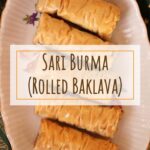
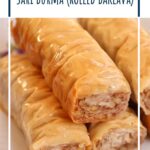
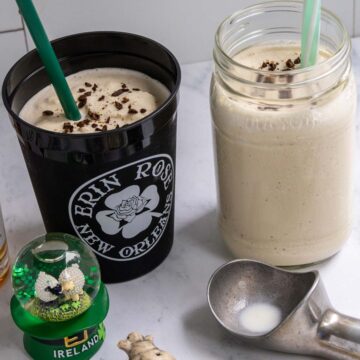
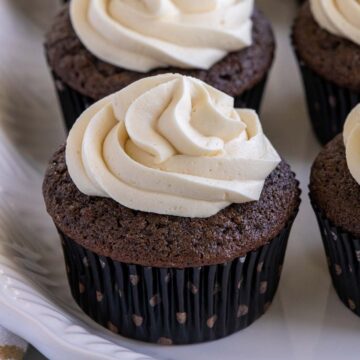


Sandra Gonzalez says
Thank you, the information you gave made it very easy to understand and follow. A keeper recipe.
Terri says
I didn't have the dowel, so just rolled it loosely rather than tight, then squished them to get the same effect. It worked well and everyone loved them. I bake regularly for work mates.
Marie Smith says
I have to admit they were even better than my mother’s. Easy to follow and worth the effort. Thank you.
Alice Miller says
The rolled Burma method is brilliant! My Armenian grandfather only taught me the traditional layered baklava. I will be trying this soon. We never used walnuts, only chopped pistachios or pecans....
Victoria says
Hi Alice,
I find this rolled method faster and easier than layering traditional baklava. I hope you enjoy it too! You can definitely replace the walnuts with pistachios or pecans. I know lots of Middle Eastern cultures use pistachios in their phyllo desserts. We just happen to prefer walnuts when we make them ourselves, but any nuts would work.